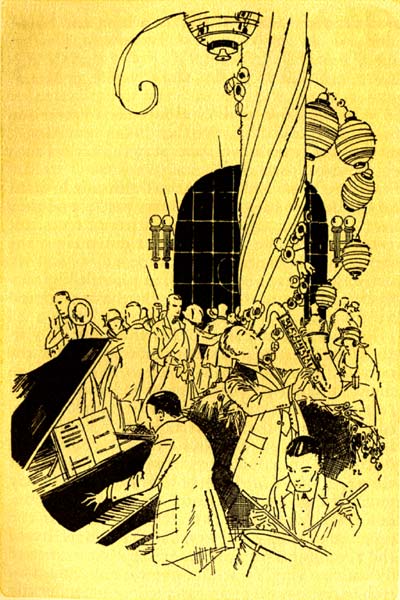| Home -> Other California Books -> Fascinating San Francisco -> Cafes and Bright Lights | |||
|
Cafes and Bright Lights
"There's a diabolical mystery to your San Francisco!" Enrico Caruso once exclaimed. "Why isn't everyone fat in this city of such excellent cafes?" The Argonauts who came to California in quest of the Golden Fleece were hearty, eaters, and they laid the foundation for a tradition of abundant table fare that has been handed down since the days of the bonanza kings. Good things to eat have been provided by successive generations of chefs who have achieved virtuosity. By and large, the moderation of prices has been a matter of bewilderment to visitors. The cheapness of savory food was one of the outstanding traits of San Francisco, in the opinion of the army of newspaper correspondents attracted to the Democratic national convention in 1920. Maurice Baring, the British author and globetrotter, goes into raptures over the cooking he discovered in a Pine street restaurant. Read his Round the World in Any Number of Days and satisfy yourself that a sophisticated observer from London town can become as ecstatic as a Gaul in the presence of soup a l'oignon. There's a diversity to the restaurants of San Francisco that makes it difficult to single out any one type. French and Italian restaurants appear to predominate, but the number of other places, including Spanish, Greek, Mexican, Hungarian and Slavonic - not to mention Chinese - makes the array a long and polyglot one. In the vicinity of Broadway, Kearny and Columbus avenue, streets that penetrate the heart of the Latin Quarter, and along upper Montgomery street, there are sufficient individual cafes to keep any explorer after atmospheric epicurism busy for many days. Neither Soho nor Montmartre is plagiarized in these places. They are foreign in tone, but they belong very much to San Francisco. What affectation and posturing there may be in Greenwich Village are not in evidence here. Joy was at times given boisterous expression in the days before the great drought came upon the land. But the eighteenth amendment and its restrictions have not deprived any of these places of their inherent buoyancy, even though they may not be as noisy as Coffee Dan's. Table d'hote courses are customary not only in the French restaurants but in most of the Italian as well. Some of these places combine or interchange the menus of French, Italian and Swiss chefs, a piquant entree, or shellfish served bordelaise, being followed by a paste like lasagne, spaghetti or tagliarini, or by those geometric ravioli whose delights are in inverse ratio to their square. If you want fare of the realm the dining rooms and grills of the hotels are at your service, as are the restaurants along Market, Powell and other streets. The cafeteria has come northward and the tea-room and the Southern inn westward by way of New York. The typical San Francisco restaurant, however, is an institution as firmly imbedded in the life of the people as is Mile Rock in the current of the Golden Gate. The sea glamour is upon the dining places of San Francisco. Any impression of them would be lacking without some reference to sea food. Every variety of fish is sold fresh in the markets daily. A number of so-called fish grottos specialize in fish caught the same morning, keeping them swimming in illuminated window-tanks. Crabs, shrimps, oysters, clams and other varieties of shell fish, including the abalone with its rainbow-tinted shell, together with sanddabs, pompano and rex sole, serve to remind one that San Francisco is washed on three sides by tides of the Pacific. Perhaps when Bret Harte referred to San Francisco as "serene, indifferent of Fate," he was thinking of Sidney Smith's declaration: "Fate cannot harm me - I have dined today!" When you think of eating in San Francisco you think of bright lights and dancing. In addition to the hotels, you may dance at innumerable cafes. Influences of Old Spain dowered San Francisco with an infatuation for the fiesta. The city has always been dance-minded. Art Hickman, virtuoso of jazz orchestration, was called to New York to have the Follies on The Roof dance to the exuberant strains he had evolved in San Francisco. Patterns of new dance forms were derived by Pavlowa from the wild rhythms she found on the old Barbary Coast. The Palais Royal, Marquard's, Tait's-at-the-Beach, the Cliff House - but where is one to stop when he starts to name the San Francisco cafes that attract dance crowds? Let's leave it to the classified lists in the telephone directories. |
|||
 |
|||
|
Jazz Masters
At most of the popular cafes you dance when you dine |
|||